|
Photographing lightning strikes and other ultra-high-speed events is next to impossible without the aid of some kind of triggering system, due to the rate at which these anomalies occur. Ubertronix Strike Finder triggers are an intelligent solution for recording these instances since they utilize several different technologies to detect motion in an accurate and repeatable way.
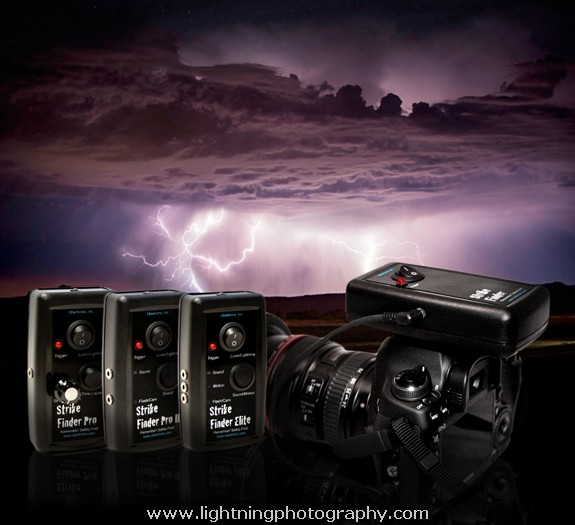
The Strike Finder line of triggers offers four unique models: the Strike Finder, Strike Finder Pro, Strike Finder Pro II and Strike Finder Elite. Each of these triggers features a different combination of means by which to record lighting strikes and other functions, depending on your own needs.
Strike Finder
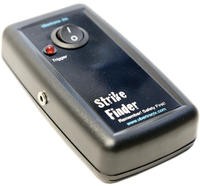 The Strike Finder is the original model, which is designed most simply to record lighting strikes during either the day or nighttime. It uses microcontroller-based technology and an infrared sensor to capture lighting and other fast, sudden bursts of light in instantaneous fashion; faster than one's dependable reaction time. This trigger mounts on the hot shoe of your DSLR and permits automatic, hands-free recording of storms. Depending on the specific storm, lighting bursts can last up to several hundred milliseconds and contain numerous individual strikes, occurring approximately 40 milliseconds apart. The Strike Finder is capable of reacting in microseconds, which when coupled with an average camera's shutter lag, provides a dependable solution for recording fast-moving lightning storms.
The Strike Finder is the original model, which is designed most simply to record lighting strikes during either the day or nighttime. It uses microcontroller-based technology and an infrared sensor to capture lighting and other fast, sudden bursts of light in instantaneous fashion; faster than one's dependable reaction time. This trigger mounts on the hot shoe of your DSLR and permits automatic, hands-free recording of storms. Depending on the specific storm, lighting bursts can last up to several hundred milliseconds and contain numerous individual strikes, occurring approximately 40 milliseconds apart. The Strike Finder is capable of reacting in microseconds, which when coupled with an average camera's shutter lag, provides a dependable solution for recording fast-moving lightning storms.
Strike Finder Pro
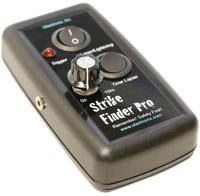 The Strike Finder Pro adds to the original Strike Finder's lightning-triggering capabilities with two more triggering systems: a laser trigger sensor and an intervalometer. The laser trigger function requires the use of an optional auxiliary laser pointer in order to emit a controlled beam of light. When this beam is interrupted it will automatically trigger an exposure within 45-60 milliseconds. This is especially useful for photographing water droplets or other instantaneous motions that occur within a relatively nearby space.
The Strike Finder Pro adds to the original Strike Finder's lightning-triggering capabilities with two more triggering systems: a laser trigger sensor and an intervalometer. The laser trigger function requires the use of an optional auxiliary laser pointer in order to emit a controlled beam of light. When this beam is interrupted it will automatically trigger an exposure within 45-60 milliseconds. This is especially useful for photographing water droplets or other instantaneous motions that occur within a relatively nearby space.
The Strike Finder Pro also integrates an intervalometer in order to facilitate time-lapse photography. The shooting intervals are controlled by a knob on the device, which allows you to fine-tune from one second to 10 minute delays between exposures. Once the time has been set, the device will automatically send a signal to your camera to make an exposure at the specified time, until you stop it.
Strike Finder Pro II
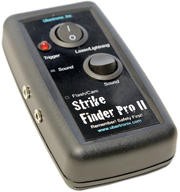 The Strike Finder Pro II is similar to the Strike Finder Pro in that it includes three separate triggering methods. However, it offers sound triggering instead of an intervalometer function. The sound trigger will automatically send a signal to your camera to make an exposure when a loud noise is detected. The sound attachment is connected to the Strike Finder Pro II via an included 18" cable, allowing you to place the trigger just off-camera, pointed in any direction. The sound trigger is ideal for photographing high-speed situations, such as races, or when firing a gun.
The Strike Finder Pro II is similar to the Strike Finder Pro in that it includes three separate triggering methods. However, it offers sound triggering instead of an intervalometer function. The sound trigger will automatically send a signal to your camera to make an exposure when a loud noise is detected. The sound attachment is connected to the Strike Finder Pro II via an included 18" cable, allowing you to place the trigger just off-camera, pointed in any direction. The sound trigger is ideal for photographing high-speed situations, such as races, or when firing a gun.
Strike Finder Elite
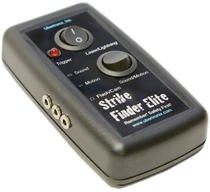 The top-of-the-line Ubertronix trigger, the Strike Finder Elite, combines four triggering technologies in one unit: lightning, laser, sound and motion. The lightning, laser and sound triggering functions have been carried over from the Strike Finder Pro II, and the addition of the motion sensor gives the Elite model greater functionality for recording high-speed situations. Like the sound trigger, the motion trigger is an auxiliary attachment that is plugged into the Strike Finder Elite through an 18" cable. This triggering system can detect any motion in order to release your camera's shutter at a greater proximity than the laser trigger.
The top-of-the-line Ubertronix trigger, the Strike Finder Elite, combines four triggering technologies in one unit: lightning, laser, sound and motion. The lightning, laser and sound triggering functions have been carried over from the Strike Finder Pro II, and the addition of the motion sensor gives the Elite model greater functionality for recording high-speed situations. Like the sound trigger, the motion trigger is an auxiliary attachment that is plugged into the Strike Finder Elite through an 18" cable. This triggering system can detect any motion in order to release your camera's shutter at a greater proximity than the laser trigger.
When using any of the Strike Finder models, it is recommended to override the manual sleep function on your camera so it is always ready to record. Also contributing to greater success, it is best to set your camera to manual focus and shutter- or aperture-priority modes, which offer faster overall performance. When working at night, the recommended exposure range is 1/3 to 1/8 second at f/1.8 to f/7.1, and when working during the day, it is best to photograph between 1/8 to 1/30 second at f/1.8 to f/7.1; no matter the time of day, it is recommended that you set your camera's sensitivity between ISO 200 and 400.
The Strike Finder trigger system is a simple and effective way to record high-speed events that would otherwise be nearly impossible to capture on your own. Making use of several distinct triggering technologies across the line of different devices, each of these triggers provides a unique solution for making precise exposures of lightning strikes and many other kinds of sudden, instantaneous movements.
|
